By Sherrif ISSAH (Alhaji)
The Sherrif Security Indicator (TSSI) is an annual online survey that is organized to commemorate the Cyber Security Awareness Month. TSSI researches into the most critical security concerns of residents of Ghana. This is the fifth edition of the survey.
TSSI asks respondents to indicate their greatest and least security concerns from the following nine security threats: disaster/epidemic, hacking, identity theft, inability to meet financial obligations, mobile money fraud, payment card fraud, personal safety, security of online banking/shopping, and national security.
Respondents in this year’s survey rated their inability to meet their financial obligations and their personal safety as their greatest security concerns, whilst they rated mobile money fraud as their least security concern.
Acknowledgement
Responses received for this year’s survey have increased tremendously due to the support of some dedicated individuals. We are very grateful to the following individuals for their contribution: Derrick Amanfu, Jemimah Odame Mensah, Owusu Sekyere Kwadwo Marfo, Abdul Karim Issah, Dzivor Daniel Dodzi, Ebenezer Kwesi Sewu, Michael Rodney Attoh, and Abdul Rahman Annan.
Methodology
This year’s survey was conducted using online questionnaires and interviews. The questionnaires were shared via social media, whilst some respondents were physically interviewed.
The survey was conducted for a period of 5 weeks; from 5th September to 7th October 2024. Out of the 4000 persons targeted for this study, 1242 responses were received. This translates into 341% increase in responses from last year.
The respondents (persons resident in Ghana) were asked the following questions:
- What is your gender?
- What is your age range?
- What is your highest level of education?
- Which of the 9 security factors is of greatest concern to you?
- Which of the 9 security factors is of least concern to you?
Results
This section discusses the respondents’ responses to the 5 aforementioned questions. Each subsection addresses each of the responses.
Gender
Majority of the 1242 respondents were males. Females constituted 40% of the respondents, as shown in figure 1.
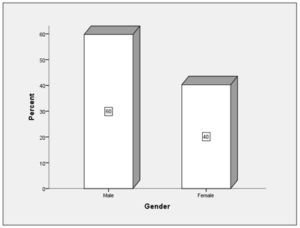
Age
Majority of the respondents were between age 18-25. Figure 2 provides the detailed age distribution.
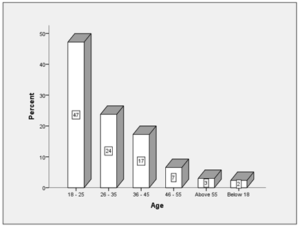
Educational level
Majority of the respondents (78%) had tertiary education, whilst 2% had no formal education. Figure 3 provides the detailed educational qualifications of the respondents.
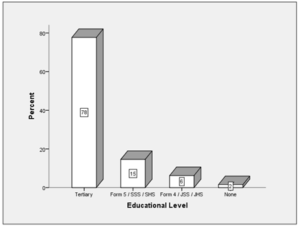
Greatest security concern
Majority of the respondents ranked their inability to meet their financial obligations, and their personal safety as their greatest security concerns, among the 9 security threats. This was followed by national security. Figure 4 provides the detailed responses.
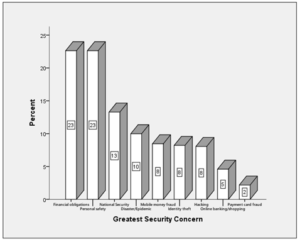
In segregating the responses per demography, majority of the males ranked their inability to meet their financial obligations as their greatest security concern, whilst majority of the females ranked their personal safety as their greatest security concern.
Majority of the respondents between ages 18-25, above 55, and below 18, ranked their personal safety as their greatest security concern, whilst majority of the respondents between age 26-55 ranked their inability to meet their financial obligations as their greatest security concern.
Majority of the respondents who had no education, and those who completed first cycle education, ranked their personal safety as their greatest security concern, whilst majority of the respondents who completed second cycle and tertiary education, ranked their inability to meet their financial obligations as their greatest security concern.
Least security concern
Majority of the respondents ranked mobile money fraud as their least security concern, followed by payment card fraud, and impersonation (identity theft). Figure 5 provides the detailed responses.
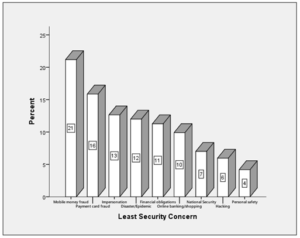
In segregating the responses per demography, majority of both males and females ranked mobile money fraud as their least security concern.
Majority of the respondents between ages 46-55, ranked payment card fraud as their least security concern, whilst majority of the rest of the age groups ranked mobile money fraud as their least security concern.
Majority of the respondents who completed first cycle education, ranked disaster/epidemic as their least security concern, whilst majority of those with no education ranked online banking/shopping as their least security concern. Also, majority of those who completed second cycle and tertiary education, ranked mobile money fraud as their least security concern.
Analysis
The findings indicate that, out of the 9 security threats, the respondents’ inability to meet their financial obligations, and their personal safety were their greatest security concerns. The vast percentage difference between the top 3 greatest security concerns, clearly demonstrates how important financial obligations and personal safety is of utmost concern to the respondents. It is also evident that gender, age and educational levels of the respondents had some level of influence on their greatest security concerns.
Mobile money fraud was the least security concern of the respondents. It is evident that age and educational levels of the respondents had some level of influence on their least security concerns. However, respondents’ gender did not influence their least security concerns. The top 3 least security concern of the respondents (i.e. mobile money fraud, payment card fraud, and identity theft) are all information security related concerns.
In comparing the findings within the past 5 years of the survey, respondents have consistently ranked their inability to meet their financial obligations and their personal safety as their greatest security concerns. Mobile money fraud has also consistently been the least security concern of the respondents. This trend can be attributable to many intrinsic and extrinsic factors. Table 1 shows the trend analysis of the past findings.
| TSSI Survey Years | |||||
| 2020 | 2021 | 2022 | 2023 | 2024 | |
| Greatest Security Concern | Payment card fraud | Financial obligation | Personal safety | financial obligations | Financial obligations & Personal safety |
| Least Security Concern | Malware/hacking | Identity theft | Mobile money fraud | Mobile money fraud | Mobile money fraud |
Table 1: Trend analysis of past TSSI findings
Conclusion
The findings clearly demonstrate the importance of financial and personal security, over information security concerns, to the respondents. It should however be noted that, inadequate management of information security concerns, can significantly impact our financial and personal security.
The trend analysis clearly demonstrates how the findings truly reflect the security concerns of the Ghanaian community. The tremendous increase in the number of respondents for this year (341% from last year) did not influence the outcome, compared to the past 3 years. The outcome of the survey can therefore be confidently generalized for persons resident in Ghana.
We are very grateful to the respondents and all those who have been supporting this survey in diverse ways. We count on your continuous support, and may the almighty Allah bless you abundantly.
The author is an Information Security Consultant, and Director of Information Security and Data Protection, IIPGH)
For comments, contact author [email protected] | +233243835912










